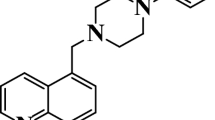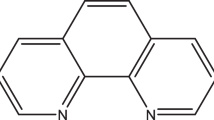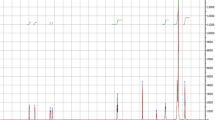Abstract
The inhibition activity of a new tetraphosphonic acid (TPA), 2-hydroxy-5-[4-hydroxy-3,5-bis(phosphonomethyl)benzyl]-3-(phosphonomethyl)benzylphosphonic acid, for carbon steel in aerated 3 % NaCl solution, at 1000 rpm, was investigated using open circuit potential (OCP), potentiodynamic polarizations, and electrochemical impedance spectroscopy (EIS) to evaluate the TPA inhibition efficiency. The steel surface was also examined by SEM observations and energy-dispersive X-ray (EDX) analysis. The inhibition efficiency increased with TPA increasing concentration up to 10−3 mol L−1 where the highest inhibition efficiency (88 %) was obtained. The thermodynamic parameters—adsorption equilibrium constant, standard free energy, and activation energy—were calculated to determine the corrosion inhibition mechanism. Results from potentiodynamic polarization and electrochemical impedance spectroscopy revealed the mode of inhibitive action and adsorption of inhibitor molecules. Further, surface morphological examination supports the protective film formation by TPA on carbon steel surface. Inhibitor adsorption was spontaneous (ΔG < 0), supported the physical/chemical adsorption mechanism, and obeyed to the Langmuir adsorption isotherm.









Similar content being viewed by others
References
Hammache H, Makhloufi L, Saidani B (2003) Corrosion protection of iron by polypyrrole modified by copper using the cementation process. Corros Sci 45:2031–2042
Benchikh A, Aitout R, Makhloufi L, Benhaddad L, Saidani B (2009) Soluble conducting poly(aniline-co-orthotoluidine) copolymer as corrosion inhibitor for carbon steel in 3% NaCl solution. Desalination 249:466–474
McCoy JW (1983) Chemical treatment of cooling water, 2nd edn. Chemical Publishing Co., New York, p 147
Rajendran S, Apparao BV, Palaniswamy N, Periasamy V, Karthikeyan G (2001) Corrosion inhibition by strainless complexes. Corros Sci 43:1345–1354
Gledhill WE, Feitjel TCJ, Hutzinger IO (eds) (1992) The handbook of environmental chemistry, part F, vol. 3. Springer Verlag, Berlin
Landner L, Walterson E (1993) Phosphonates used for detergent applications. Swedish Environmental Research Group (MFG), Stockholm
Jaworska J, Van-Genderen-Takken H, Hanstvert A, Plassche EVD, Feijtel T (2002) Environmental risk assessment of phosphonates, used in domestic laundry and cleaning agents in the Netherlands. Chemosphere 47:655–665
Demadis KD, Katarachia D (2004) Metal-phosphonate chemistry: synthesis, crystal structure of calcium-amino-tris-(methylene phosphonate) and inhibition of CaCO3 crystal growth. Phosphorus Sulfur Silicon Relat Elem 179:627–648
Demadis KD, Lykoudis P (2005) Chemistry of organophosphonate scale growth inhibitors: 3. Physicochemical aspects of 2-phosphonobutane-1,2,4-tricarbonate (PBTC) and its effect on CaCO3 crystal growth. Bioinorg Chem Appl 3:135–149
Holy AJ, Günter J, Dvorakova H, Masojidkova M, Andrei G, Snoeck R, Balzarini J, de Clercq E (1999) Structure-antiviral activity relationship in the series of pyrimidine and purine N-[2-(2-phosphonomethoxy)ethyl] nucleotide analogues. 1. Derivatives substituted at the carbon atoms of the base. J Med Chem 42:2064–2084
Grison C, Letondor C, Chibli H, Coutrot P (2005) One-pot carbanionic access to methylenebis(phosphonate) analogues of natural P1, P2-glycosyl-disubstituted pyrophosphates. Tetrahedron Lett 46:6525–6528
Cai ZR, Jabri SY, Jin H, Kim CU, Metobo SE, Mish MR, Pastor RM (2007) Antiviral phosphonate conjugates for inhibition of HIV, Int Patent WO2007014352, Int class: A61K31/662; A61K47/48
Darling D, Rakshpal R (1998) Green chemistry applied to corrosion and scale inhibitors. Mater Perform 37:42–45
Andijani I, Turgoose S (1999) Studies on corrosion of carbon steel in deaerated saline solutions in presence of scale inhibitor. Desalination 123:223–231
Ramesh S, Rajeswari S (2005) Evaluation of inhibitors and biocide on the corrosion control of copper in neutral aqueous environment. Corros Sci 47:151–169
Rajendran S, Apparao BV, Palaniswamy N, Amalraj AJ, Sundaravadivelu M (2002) The role of phosphonates as transporters of Zn2+ ions in the inhibition of carbon steel in neutral solutions containing chlorides. Anti-Corros Methods Mater 49:205–209
Gunasekaran G, Natarajan R, Muralidharan VS, Palaniswamy N, Apparao BV (1997) Inhibition by phosphonic acids. Anti-Corros Methods Mater 44:248–259
Balaban-Irmenin YV, Rubashov AM, Fokina NG (2006) Protection of metals. Prot Met 42:133–136
Ochoa N, Baril G, Moran F, Pébère N (2002) Study of the properties of a multi-component inhibitor used for water treatment in cooling circuits. J Appl Electrochem 32:497–504
Ochoa N, Moran F, Pébère N (2004) The synergistic effect between phosphonocarboxylic acid salts and fatty amines for the corrosion protection of a carbon steel. J Appl Electrochem 34:487–493
Nakayama N (2000) Inhibitory effects of nitrilotris(methylenephosphonic acid) on cathodic reactions of steels in saturated Ca(OH)2 solutions. Corros Sci 42:1897–1920
Garcia C, Gourbin G, Ropital F, Fiaud C (2001) Study of the scale inhibition by HEDP in a channel flow cell using a quartz crystal microbalance. Electrochim Acta 46:973–985
Starostina M, Smorodin A, Gal-Or L (1999) Inhibition by phosphates of mild steel and cast iron in cooling water. Mater Perform 38:52–58
Cushner MC, Melchior WC, Przybylinski JL (1990) Effect of iron(II) on the performance of calcium carbonate inhibitors. Mater Perform 29:49–56
Sekine I, Hirakawa Y (1986) Effect of 1-hydroxyethylidene-1,1-diphosphonic acid on the corrosion of SS 41 steel in 3% sodium chloride solution. Corrosion 42:272–277
Touir R, Dkhireche N, Touhami ME, Sfaira M, Senhaji O, Robin JJ, Boutevin B, Cherkaoui M (2010) Operational parameters effect of sodium gluconate inhibition used in the protection of cooling water system. Mater Chem Phys 122:1–9
Aliouane N, Chafaa S, Douadi T, Helesbeux JJ, Khan MA, Bouet G, Duval O (2011) Synthesis of new benzylic di-, tri-, and tetraphosphonic acids as potential chelating agents. Phosphorus Sulfur Silicon 186:354–364
Aliouane N, Chafaa S, Douadi T, Helesbeux JJ, Khan MA, Duval O, Bouet G (2010) Novel polydentate phosphonic acids: protonation and stability constants of complexes with Fe(III) and Cu(II) in aqueous medium. Heteroat Chem 2:51–62
Felhosi I, Telegdi J, Palinkas G, Kalman E (2002) Kinetics of self-assembled layer formation on iron. Electrochim Acta 47:2335–2340
Duprat M, Bui N, Dabosi F (1978) Sur le choix d’un critère de détermination de la vitesse de corrosion d’un acier au carbone dans une solution à 3% de chlorure de sodium aérée et agitée. J Appl Electrochem 8:455–465
Ochoa N, Moran F, Pébère N, Tribollet B (2005) Influence of flow on the corrosion inhibition of carbon steel by fatty amines in association with phosphonocarboxylic acid salts. Corros Sci 47:593–604
Bommersbach P, Alemany-Dumont C, Millet JP, Normand B (2005) Formation and behaviour study of an environment-friendly corrosion inhibitor by electrochemical methods. Electrochim Acta 5:1076–1084
Srisuwan N, Ochoa N, Pébère N, Tribollet B (2008) Variation of carbon steel corrosion rate with flow conditions in the presence of an inhibitive formulation. Corros Sci 50:1245–1250
Bentiss F, Traisnel M, Lagrenee M (2000) The substituted 1,3,4-oxadiazoles: a new class of corrosion inhibitors of mild steel in acidic media. Corros Sci 42:127–146
Valek L, Martinez S, Mikulic D, Brnardic I (2008) The inhibition activity of ascorbic acid towards corrosion of steel in alkaline media containing chloride ions. Corros Sci 50:2705–2709
Martinez S, Valek L, Oslakovic IS (2007) Adsorption of organic anions on low-carbon steel in saturated Ca(OH)2 and the HSAB principle. J Electrochem Soc 154:C671–C677
Touir R, Cenoui M, El Bakri M, Ebn Touhami M (2008) Sodium gluconate as corrosion and scale inhibitor of ordinary steel in simulated cooling water. Corros Sci 50:1530–1537
Amar H, Tounsi A, Makayssi A, Derja A, Benzakour J, Outzourhit A (2007) Corrosion inhibition of Armco iron by 2-mercaptobenzimidazole in sodium chloride 3% media. Corros Sci 49:2936–2945
Amar H, Benzakour J, Derja A, Villemin D, Moreau B (2003) A corrosion inhibition study of iron by phosphonic acids in sodium chloride solution. J Electroanal Chem 558:131–139
Amar H, Benzakour J, Derja A, Villemin D, Moreau B, Braisaz T (2006) Piperidin-1-yl-phosphonic acid and (4-phosphono-piperazin-1-yl) phosphonic acid: a new class of iron corrosion inhibitors in sodium chloride 3% media. Appl Surf Sci 252:6162–6172
Lenderink HJW, Linden MVD, Wit JHW (1993) Corrosion of aluminium in acidic and neutral solutions. Electrochim Acta 38:1989–1992
Garrigues L, Pébère N, Dabosi F (1996) An investigation of the corrosion inhibition of pure aluminum in neutral and acidic chloride solutions. Electrochim Acta 41:1209–1215
Bonnel A, Dabosi F, Deslouis C, Duprat M, Keddam M, Tribollet B (1983) Corrosion study of a carbon steel in neutral chloride solutions by impedance techniques. J Electrochem Soc 130:753–761
Tan YJ, Bailey S, Kinsella B (1996) An investigation of the formation and destruction of corrosion inhibitor films using electrochemical impedance spectroscopy (EIS). Corros Sci 38:1545–1561
Goncalves RS, Azambuja DS, Serpa-Lucho AM (2002) Electrochemical studies of propargyl alcohol as corrosion inhibitor for nickel, copper, and copper/nickel (55/45) alloy. Corros Sci 44:467–479
Mernari B, Elattari H, Traisnel M, Bentiss F, Lagrenee M (1998) Inhibiting effects of 3,5-bis(n-pyridyl)-4-amino-1,2,4-triazoles on the corrosion for mild steel in 1 M HCl medium. Corros Sci 40:391–399
Ramesh SV, Adhikari AV (2009) N′-[4-(diethylamino)benzylidine]-3-{[8-(trifluoromethyl) quinolin-4-yl]thio}propano hydrazide) as an effective inhibitor of mild steel corrosion in acid media. Mater Chem Phys 115:618–627
Kumar SLA, Gopiraman M, Kumar MS, Sreekanth A (2011) 2-Acetylpyridine-N(4)-morpholine thiosemicarbazone (HAcpMTSc) as a corrosion inhibitor on mild steel in HCl. Ind Eng Chem Res 50:7824–7832
Tang LB, Mu G, Liu G (2003) The effect of neutral red on the corrosion inhibition of cold rolled steel in 1.0 M hydrochloric acid. Corros Sci 45:2251–2262
Li X, Tang L (2005) Synergistic inhibition between OP and NaCl on the corrosion of cold-rolled steel in phosphoric acid. Mater Chem Phys 90:286–297
Oguzie EE (2008) Evaluation of the inhibitive effect of some plant extracts on the acid corrosion of mild steel. Corros Sci 50:2993–2998
Gomma GK (1998) Corrosion inhibition of steel by benzotriazole in sulphuric acid. Mater Chem Phys 56:27–34
Oguzie EE, Unaegbu C, Ogukwe CN, Okolue BN, Onuchukwu AI (2004) Inhibition of mild steel corrosion in sulphuric acid using indigo dye and synergistic halide additives. Mater Chem Phys 84:363–368
Ali SA, Al-Mualllem HA, Rahman SU, Saeed MT (2008) Bis-isoxazolidines: a new class of corrosion inhibitors of mild steel in acidic media. Corros Sci 50:3070–3077
Abdallah M (2002) Rhodanine azosulpha drugs as corrosion inhibitors for corrosion of 304 stainless steel in hydrochloric acid solution. Corros Sci 44:717–728
Noor EA (2007) Temperature effects on the corrosion inhibition of mild steel in acidic solutions by aqueous extract of fenugreek leaves. Int J Electrochem Sci 2:996–1017
Ahamad I, Prasad R, Quraishi MA (2010) Inhibition of mild steel corrosion in acid solution by Pheniramine drug: Experimental and theoretical study. Corros Sci 52:3033–3041
Gopiraman M, Selvakumaran N, Kesavan D, Kim IS, Karvembu R (2012) Chemical and physical interactions of 1-benzoyl-3,3-disubstitute thiourea derivatives on mild steel surface-corrosion inhibition in acidic medium. Ind Eng Chem Res 51:7910–7922
Schweinsberg DP, George GA, Nanayakkara AK, Steiner DA (1988) The protective action of epoxy resins and curing agents-inhibitive effects on the aqueous acid corrosion of iron and steel. Corros Sci 28:33–42
Shorky H, Yuasa M, Sekine I, Issa RM, El-Baradie HY, Gomma GK (1998) Corrosion inhibition of mild steel by Schiff base compounds in various aqueous solutions: part 1. Corros Sci 40:2173–2186
Zhou X, Yang H, Wang F (2012) Investigation on the inhibition behavior of a pentaerythritol glycoside for carbon steel in 3.5% NaCl saturated Ca(OH)2 solution. Corros Sci 54:193–200
Author information
Authors and Affiliations
Corresponding author
Rights and permissions
About this article
Cite this article
Saker, S., Aliouane, N., Hammache, H. et al. Tetraphosphonic acid as eco-friendly corrosion inhibitor on carbon steel in 3 % NaCl aqueous solution. Ionics 21, 2079–2090 (2015). https://doi.org/10.1007/s11581-015-1377-3
Received:
Revised:
Accepted:
Published:
Issue Date:
DOI: https://doi.org/10.1007/s11581-015-1377-3




